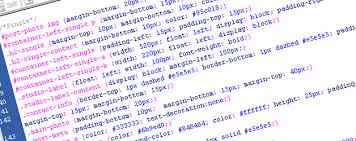
The Power of CSS in Web Design
Cascading Style Sheets (CSS) play a crucial role in modern web design, offering developers the ability to control the visual presentation of a website with precision and flexibility.
One of the key advantages of CSS is its ability to separate content from design, allowing for cleaner and more maintainable code. By defining styles in a separate CSS file, web designers can easily make global changes to the appearance of a website without having to modify each individual webpage.
CSS also enables responsive design, making websites adaptable to different screen sizes and devices. Media queries in CSS allow developers to create layouts that adjust seamlessly from desktops to tablets to smartphones, providing users with an optimal viewing experience across various platforms.
Furthermore, CSS offers a wide range of styling options, including custom fonts, colours, layouts, animations, and more. With CSS preprocessors like Sass and Less, developers can streamline their workflow by using variables, mixins, and functions to write cleaner and more efficient code.
In conclusion, CSS is an essential tool for creating visually appealing and functional websites. Its versatility and power make it a fundamental component of modern web design practices.
Essential CSS Tips for Effective and Modern Web Design
- Use a consistent colour scheme throughout your website for a cohesive look.
- Optimise images to improve page loading speed and overall performance.
- Implement responsive design to ensure your site looks good on all devices.
- Organise your CSS code using comments and meaningful class names for easier maintenance.
- Utilise CSS grid or flexbox for efficient layout design without relying heavily on floats.
- Stay updated with the latest CSS trends and techniques to enhance your web design skills.
Use a consistent colour scheme throughout your website for a cohesive look.
Using a consistent colour scheme throughout your website is a fundamental tip in CSS web design that can greatly enhance the overall user experience. By maintaining a cohesive palette across all pages, you create a sense of unity and coherence that helps users navigate your site with ease. Consistency in colours not only reinforces your brand identity but also contributes to the visual harmony of the design, making the website more visually appealing and engaging for visitors. This simple yet effective practice can elevate the aesthetics of your site and leave a lasting impression on users.
Optimise images to improve page loading speed and overall performance.
Optimising images is a crucial aspect of CSS web design to enhance page loading speed and overall performance. By resizing images to the appropriate dimensions and compressing them without compromising quality, web developers can significantly reduce file sizes, leading to faster loading times for users. Utilising CSS techniques like responsive images and lazy loading further optimises image delivery, ensuring a smoother browsing experience while maintaining visual appeal on different devices. Prioritising image optimisation in CSS design not only improves website performance but also enhances user engagement by creating a seamless and efficient online environment.
Implement responsive design to ensure your site looks good on all devices.
Implementing responsive design is crucial in CSS web design to ensure that your site looks good and functions well on all devices, regardless of screen size or resolution. By using media queries and flexible layout techniques, you can create a seamless user experience that adapts to different devices, from desktop computers to smartphones. This approach not only enhances usability but also boosts accessibility and user engagement, making your website more inclusive and user-friendly across various platforms.
Organise your CSS code using comments and meaningful class names for easier maintenance.
When working on CSS web design, it is essential to organise your code efficiently to ensure easier maintenance in the long run. By incorporating comments and using meaningful class names throughout your CSS files, you can enhance readability and streamline the debugging process. Clear comments help document the purpose of specific sections of code, making it easier for you or your team members to understand and update the styling when needed. Additionally, employing descriptive class names that reflect their intended function not only improves code clarity but also simplifies future modifications and enhancements to your website’s design.
Utilise CSS grid or flexbox for efficient layout design without relying heavily on floats.
When designing a website, it is advisable to utilise CSS grid or flexbox for efficient layout design without relying heavily on floats. CSS grid and flexbox offer more robust and intuitive ways to create responsive layouts, allowing designers to easily organise content in a structured manner. By using these modern layout tools, developers can achieve better alignment, spacing, and overall design consistency across different screen sizes without the complexities and limitations associated with floats. This approach not only streamlines the development process but also enhances the overall user experience by ensuring a more fluid and adaptable layout design.
Stay updated with the latest CSS trends and techniques to enhance your web design skills.
Staying updated with the latest CSS trends and techniques is essential for enhancing your web design skills. By keeping abreast of new developments in CSS, such as emerging layout methods, animation techniques, and best practices, you can ensure that your websites are not only visually appealing but also optimised for performance and user experience. Continuous learning and experimentation with new CSS features will enable you to push the boundaries of your design capabilities and stay ahead in the ever-evolving field of web design.
